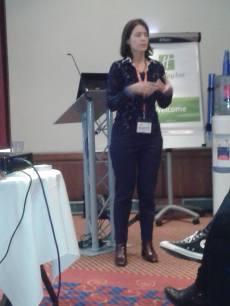48th ANNUAL INTERNATIONAL IATEFL Conference – Harrogate 2014
AUTHENTIC TECHNIQUES TO DEVELOP BUSINESS SKILLS
“Management games” are one of the most commonly used training techniques in communication skills programs. Participants need to solve a challenging situation by applying an interpersonal skill, while they interact with others in n unstructured situation. There is direct involvement of the participant, there is collaboration and fun. This is an experiential learning process. The basis of the experiential learning process is David Kolb’s learning cycle theory: do, review and improve. We can borrow these management games and adapt them to our classroom activities so that our Business English learners may live a similar learning experience, but this time in English.
GAME 1
The first technique is called “Step Out”; it is used to develop persuasion and influencing skills. The trainer puts participants in pairs. Then marks a circle on the floor and asks for 2 volunteers to step inside. Their goal is to convince the other to step out of the circle within a time limit. They can use any influencing technique, except physical force. During the performance, the trainer observes. The others may be asked (or not) to encourage their colleagues. The game is over when one of the participants steps out or time is up. Wrap-up to reflect on the experience. Who really won? The one who remain inside or the one who stepped out in exchange for something he negotiated? What influencing technique did they use? Whose method was more effective? Did they make eye contact? Use their voice persuasively? Body language was friendly or intimidating? What was the role of the audience? What is the most important lesson regarding persuasion skills?
This review stage is as important as the performance because participants reflect on their strengths and weaknesses, and the trainer may give feedback.
How to integrate this activity in our classes? Integration Plan
As teachers we should integrate skill development and language in our lesson planning in a meaningful way for our business learners, so that they perceive an added value in our service. There are two key variables to consider in this is integrations process:
- Language level: how operational is the English level of our group? In many cases, we may need to teach or review the language of persuasion.
- Teaching objective: as language trainers, we should always havea teaching goal behind the decision to use this activity. For example, once I was teaching an Intermediate group, we were doing a unit from the course book (Business Advantage Intermediate) that covered Negotiating skills. I decided to use Step Out in order to give a closing to the unit, to round it off. Then, our objective helps us to determine how to continue with the integration plan.
During the Input stage, my SS learnt the language to develop a logical argument: the use of conditionals and modals to describe the consequences of a proposal, the benefits and drawbacks of an offer. They learnt to identify share value in a negotiation. We made a revision of connectors of Reason & Contrast that are used in this type of exchanges. The unit also included conversational expressions such as “…so that means…., “. My SS learnt the language of persuasion at an intermediate level.
But language structures are not enough to apply a business skill. We need to raise SS’s awareness of the elements that make up personal interaction. This means organizing our discourse in a influencing way: the language structures need to be accompanied by rapport building, empathy, active listening, making effective questions. Only then will language structures acquire a persuasive impact. We also need to use non verbal communication (eye contact, gestures and body language and use of voice). I used the following sources to develop persuasion and influencing skills:
Win Win Negotiation Theory: video http://www.youtube.com/watch?v=hqn4azeHikc
Reading: The Four Essential Elements: http://hbr.org/1998/05/the-necessary-art-of-persuasion/ar/1
And put this material in practice with guided role plays.
Now my intermediate SS were reasonably equipped with language, were aware of the skill and were confident to perform. I recorded them and they watched themselves in the feedback session. As an output task, they made a list of the emotions they felt while performing. Why emotions? Because emotions form part of our experience and by acknowledging the positive ones, we help SS be self confident and by detecting the negative ones we help them detect their weaker areas. As NNSs, they were unconfident, afraid, shy, enthusiastic, anxious, alert, nervous, joyful, grateful, and so on.
GAME 2
The second technique is called “Early Bird and Second Mouse”. It is based on the funny one-liner “the early bird may get the worm, but it’s the second mouse who gets the cheese”; two contradictory ideas in the same sentence.
The trainer splits the group in 2 teams and assigns one half of the liner to each of them. Each team has to discuss why their half is the best strategy for business (or for a given project, or a situation or for life) and then make a 2, 3 minute presentation. All the team members have to contributewith their opinions, thoughts, abilities and know how to this decision. After the presentations, the group holds a debate. We may explore different areas/topics, depending on your underlying training objective:
- Different strategies for different situations: adaptability vs consistency
- Different strategies for different type of people, personality, companies, cultures
Some of the business skills we can help develop with this game are: Teambuilding, Decision making and Problem solving.
Integration plan.
- Level: My group was advanced level (C1) and we’d already covered the language items used in meetings (giving, discuss opinions, reach a decision, agree and disagreeing) they did not need any language input.
- Objective: my teaching objective was to use this activity as a lead in to kick off the following topic of the syllabus (Teamwork)
To achieve this goal, I designed a thought- provoking review session. While the two teams were discussing their ideas, I observed how each of them put forward their contributions and the roles they adopted (leader, the follower, the compromiser) and took down notes of these behaviors. The teams made their presentations. For the review, I prepared questions (based on (https://www.kent.ac.uk/careers/sk/teamwork.htm)
What type of contributions did you make? How did the team deal with disagreement? Do you feel your opinions were listened to? About their own experience in teams.
To elicit information about team roles, I wrote “team roles” and brainstormed the concept and together made a mind map. We discussed the different roles team members adopt based on researcher R. Meredith Belbin ( http://www.belbin.com/) , what problems they faced and how to overcome them
At this stage, my advanced learners were enthusiastic and looking forward to beginning with the new topic. The activity raised their awareness of team building skills and their interest to keep on learning.
Highlights to Integrate these Game in a Business English Class
Review and feedback:
- Plan this stage as part of the integration, it is the opportunity for students to reflect and draw their conclusions.
- Use open questions, leading questions that engage learners and facilitate discussion. We can also use other formats, multiple choice, mind maps,
- Highlight the positive features of SS’s performance with short, clear ideas, and then I give concrete suggestions for improvement in weaker areas.
- Focus on the effectiveness of the message not on strictly accuracy.
The Role of the teacher in this type of activities
- When the instructor gives input: teachers
- During the game performance, we enable the process: facilitators.
- In the review and feedback session: coaches.
We cannot be teachers during the performance, or during the feedback. As it would distort the purpose of the technique.
To conclude, these games create an opportunity for experiential learning and can be adapted to the course profile and needs. By incorporating these games, we can add value to our classes and boost our learners self confidence, as long as we have a teaching goal, gives constructive feedback and follow the 3 roles of the instructor: teacher, facilitator and coach.




